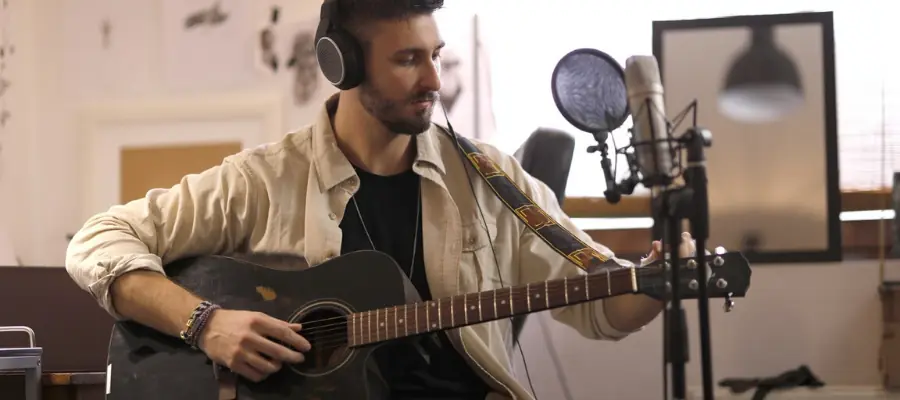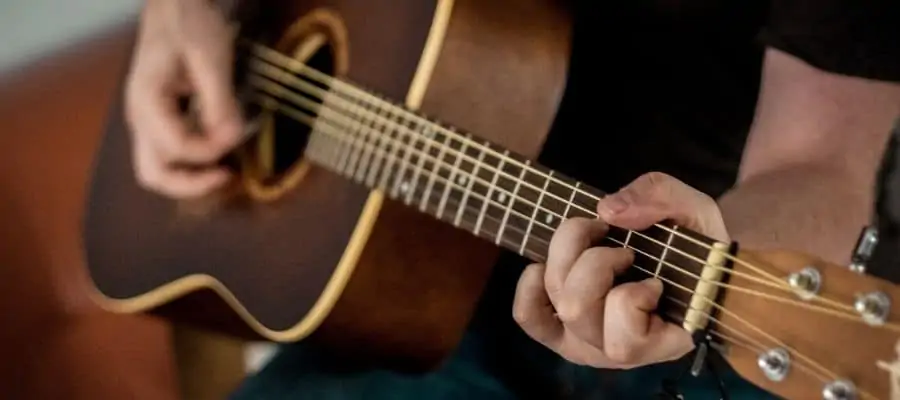I don’t think it would be an exaggeration to call a metronome the most underappreciated tool a guitarist has at their disposal. Understandably, practicing with a metronome has this feeling of a dull practice session with never-ending loops of boring exercises. All of this to eventually be able to enjoy those 10 seconds where you nail that lick or riff. And then repeat over and over.
There is so much more to a metronome when used properly. It can be a tool that helps you develop so many crucial elements of your playing and your creativity. Do not be fooled by Eddie Van Halen’s rock and roll demeanor, he surely used a metronome to develop those amazing skills.
Improves Your Timing
In music, timing is one of the most important elements to develop. Having good or bad timing can be a deciding factor in how well you can create and perform music. If you have good timing, you can dedicate your energy to creating rhythms and atmospheres without having the issue of continuity.
Having bad timing will make your music stale and interrupted.
Timing is also one of the most noticeable things that if not working, will make that energy in a performance not exist. On the other hand, someone with good timing is able to translate that energy into a groove. This will, in turn, translate into a strong influence on the people listening, making them dance, headbang, or simply tap their feet.
A metronome can be a very useful tool in this matter. It is by dedicating your attention to locking in with a click that you can begin to form a strong sense of internal timing.
Enables You To Build Speed

One of the most common mistakes a guitar player makes is not having the patience required to properly learn a piece of music. This holds especially true when that riff, lick or song goes at a fast tempo.
This can lead to a dangerous habit of being able to play fast but with mistakes along the way. It can also negatively reinforce a lack of detail when it comes to playing the guitar. It is essential to take a complex or fast segment of a song and slow it down to a point where you can play it with ease.
You can use a metronome to figure out that tempo, focus on all of the detail required to bring life to that segment, and only then slowly build your speed. This will ensure that every single note you play has an intention behind it. This will dramatically expand your abilities as a guitar player.
If you are having trouble staying motivated to play the guitar every day, you must check out my post How I Motivate Myself To Play Guitar Every Day – 15 Tips
Develops Your Inner Groove

One of the most crucial qualities a pro musician has is a solid sense of groove. The ability to quickly lock into any sort of musical movement helps them perform in any kind of style and tempo. This makes them an all-rounded musician.
A metronome is essential to this task and can help you create and develop inner groove. Granted, to be able to groove, you first have to have heard a specific groove. This is why I believe drum beats are essential in this process.
However, if you are already comfortable with drum beats or backing tracks and wish to take a step further, a metronome is the way to go.
Having an uninteresting, monotone sound such as a click can open your mind to practice imagination and connect through that. If you place a metronome at whatever tempo you wish and then imagine a drum groove, it is much easier to lock into it.
The great thing is it also reinforces that part of the brain that focuses on creativity and will do wonders for your improvisation skills.
Helps You Play Slow Grooves Comfortably

There is an interesting tendency most guitarists have that when playing medium to fast stuff. If there are no technique impediments, it is more than likely that you have good timing and lock into the groove faster.
Therefore, it would seem logical that music that goes at slower tempos will be just as easy if not easier to lock into, right? Wrong.
Slower tempos tend to bring out timing issues for most guitar players and that is because our bodies and minds are not organically used to slow movement. We live in such a fast-paced world that in a way, it makes perfect sense that we’d have difficulties slowing down. It is only natural that this will also affect our ability to groove at slow tempos since they feel unnatural.
A metronome can help you get used to these tempos and quickly create a frame of mind that moves and grooves even to slow music. This will open all sorts of opportunities for you.
Develops Rhythm Subdivision Awareness

Groove and rhythm are not one the same. Groove relates more to a physical, body-driven expression of music. On the other hand, rhythm can be considered as the language used within that expression.
Having said that, it is important to develop a clear understanding and familiarity with the language of rhythm and how it can be chopped up into smaller pieces.
You can take a whole note (1) and divide it into a half note (½), then to a quarter note (¼), then to an eighth note (⅛), to a sixteenth note (1/16) and so on. You can mix and match in all sorts of ways to create different grooves. You know this. However, it is very different to have a theoretical understanding than it is to be able to listen to it in your head.
If you want to learn more about music theory you can check out my post Guitar Music Theory In-Depth Basics
A metronome serves as that tool to lay down the foundation where you can experiment with different rhythms, subdivisions, and accents. This will enable you to properly follow and/or create all sorts of grooves.
You Familiarize Yourself With Different Tempos And Time Signatures

Same as with rhythms, familiarizing yourself with different tempos and time signatures can open up a world of creativity for you. It is no small feat to be able to listen to a song and accurately guess its tempo and feel.
If I mention Michael Jackson’s song, “Billie Jean”, it is more than likely you will begin to listen to it in your head. You already know its speed, groove, and feel but did you know that it has a tempo of 117 bpm? Once you are able to internalize that, you can instinctively know what a tempo of 110-120 bpm sounds like.
Using a metronome at different tempos can allow you to get familiarized with the speed and feel of any bpm you desire. This works the same way for time signatures for anyone who’s interested in odd-meters and more complex compositions.
Forces You To Listen To External Sounds

This is one of the most overlooked skills a musician can have, especially for beginners. It is such a mentally consuming task to be able to play the right chords with the proper groove, that it takes time before we get comfortable with it.
Once that stage has passed, some of your mental energy is released to focus on other things.
This is where it is crucial to understand that the next natural step is to focus on external sounds that influence your performance. If you are in a live situation, paying attention to what every band member is doing can help you achieve a better understanding of how music works.
Not to mention it also enables you to connect with your fellow musicians and audience, which in the end, is what we are looking for.
When using a metronome, being able to step outside of your guitar and listen clearly to the click without losing the groove is a great skill to develop. This will allow you to manage and direct your attention in more productive ways.
If you still don’t have one, you can check out my recommendation Top 27 Must Have Guitar Accessories For Every Guitarist
Prepares You For Studio Recording Situations

Performing live vs. recording in a studio are two completely different experiences that require different skills. Anyone who has lived the recording studio experience can attest to this.
The two most noticeable things you can see when in a recording scenario are the following: every single nuance you can hear on a guitar such as string friction or a slightly out of tune bend will be extremely noticeable.
The second thing is that you’ll realize that playing to a click and making it sound real and organic is much harder than you would think.
It is a rite of passage to have this experience, there is no way around it. However, whether you have never had the opportunity to record, or are familiarized with these recording issues, a metronome is your solution.
Getting used to making yourself sound good while following a click track is a skill you’ll want to master and the only way to do this, is to play to a metronome.
Allows You To Log And Quantify Progress

A solid practice routine with a clear intention of your goals can help you massively improve your musicianship. One of the most overlooked things when setting up a practice routine is taking the time to log and quantify your progress.
What tempo are you currently in with that song? At what tempo are you dominating your rhythm hand? At what tempo do you have problems? All of these questions should be asked when taking a look at your progress.
Using a metronome as a tool to quantify your progress has proven to be very helpful. By setting yourself to practice at specific tempos, you can have an accurate look at where you feel comfortable and where you need more work.
Setting yourself tempo goals is also a good way to look at your process and achieving said goals helps you motivate yourself to keep going.
Allows You To Play With Backing Tracks Live

As music evolves, so does the production of live shows. It wouldn’t be a surprise that a gig you are hired for has backing tracks as part of the performance. At that point, a click track might be required for you to follow all the cues needed to follow the music.
Granted, this job is usually left to drummers who will then guide you through the music. Nevertheless, having that ability to manage a situation where you need to follow a click track can be a make or break for that gig.
By practicing with a metronome constantly, you familiarize yourself with following a click track.
The next step is not to only follow a click track but to also be able to create that energy needed on a live show without speeding up or losing the groove. After all, being able to rock the crowd is a very important skill a touring musician needs to develop.
Opens Creative Possibilities

Everything we do on a guitar, every practice routine or exercise should be intended to make better music. The idea behind learning techniques, rhythms, or chord progressions is to expand our creativity.
The more we learn, the more we can draw from when improvising, jamming, or writing music.
The metronome is a great tool to experiment with different rhythms, time signatures, groove patterns, and chord phrasings. By having a steady click that doesn’t suggest any sort of groove, you are left with all sorts of creative possibilities that will help you explore different paths to make music.
A metronome will also help you not lose momentum if at some point you misplay something or wish to change some rhythms. You will probably have to stop to figure it out, but the metronome will help you quickly jump back into time and continue to experiment with your musical tools.
Leads You To Develop Confidence To Lead Musicians

This is something that becomes particularly obvious to drummers. Being able to keep time is one thing, but to create time is another. Having a strong inner sense of time and groove, while at the same time being able to properly perform is an important skill.
Developing this skill takes time and experience.
Using a metronome allows you to practice developing the confidence to eventually realize you don’t need a metronome. Being able to create rhythm and groove is an innate characteristic in humans. It is through practice and persistence you can strengthen your inner timing and groove.
A common situation you can find yourself in is if you are backing up a singer in a guitar/vocals configuration. It is then that you will need that inner groove to create your own atmosphere and let the singer glide over it.
Helps You Practice Without An Instrument

This is probably one of the most difficult activities to develop as a musician. Being able to hear music in your head and then connect it to your guitar is a challenging task. However, I guarantee you there is no greater pleasure than to be able to make that mind-ear-hand-guitar connection.
In reality, this is something that you can do any time, any place. It is more than likely that you will need the freedom of not having a tempo to first begin developing this skill. After a while, adding a tempo to this practice can help you create grooves and rhythms without needing an instrument.
The great thing about this practice is that by not having an instrument, your creativity has fewer limits. The real challenge will be for you to be able to connect those ideas to the fretboard.
Lets You Focus On A Deeper Level

Focus is one of the most powerful skills we can learn. It is through our awareness we realize whatever we set our mind to do, can and will eventually be done. The main issue we face, not only as musicians but as human beings, is our inability to focus intently on something for long periods.
Most of the time, we are multi-tasking and splitting our attention to focus on multiple things all at once. Granted, there are moments where that skill is valuable. However, being able to focus on that one thing and let all your energy pour into that thing, is a skill we must develop.
You can use a metronome as a tool to enhance this skill. By devoting all of your attention to the click and how your playing reacts to it, you can enter this soothing mental state where you can begin to develop a strong sense of focus and attention.
Enables You To Become A Better Musician
All of the resources listed above have only one purpose, making you a better musician. Mastering music is a never-ending journey that will take you through worlds your imagination hasn’t even dreamed of.
This journey only asks of you to have the patience and devotion to experiment and explore without any limitations.
Developing a sense of rhythms, inner groove, feel and energy are just some of the crucial elements you will need to master to create good music. The main barriers you will face are the limitations your technique will have at any given point.
Having a metronome as one of your cornerstone tools will prove to be helpful on your journey to break down those barriers and create music.
Conclusion
Using a metronome can sometimes be a daunting task. It can get dull and boring quickly and take away all the joy in practicing and making music.
For anyone that is not used to including a metronome in their practice routine, start slowly. Just pick one or two exercises you are working on and gradually incorporate your metronome into the practice.
Having a clear intention and understanding of why you should use a metronome will be key in taking in all of the great advantages it provides to you.
If you found this article useful, you may want to save this pin below to your Guitar board.

Recent Posts
When learning new songs have you noticed that some of the chord sequences sound really good? But when you tried to come up with your own chord sequence, or as we call it chord progression, you found...
Some guitarists insist on buying an expensive amplifier with their electric guitar. They assume that this is a must for every type of guitarist out there. However, in some situations, this isn’t...



